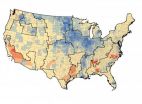(Press-News.org) Measuring the levels of a natural body chemical may allow doctors to reduce the duration of antibiotic use and improve the health outcomes of critically ill patients.
"Infection is a common and expensive complication of critical illness and we're trying to find ways to improve the outcomes of sick, elderly patients and, at the same time, reduce health care costs," says Daren Heyland, a professor of Medicine at Queen's, director of the Clinical Evaluation Research Unit at Kingston General Hospital, and scientific director of the Technology Evaluation in the Elderly Network.
Prolonged antibiotic exposure is associated with an increase in drug-resistant pathogens. It makes sense, according to Dr. Heyland, to examine ways in which we might make the duration of antibiotic treatment more precise without compromising patient outcome.
Dr. Heyland and Queen's research colleagues John Muscedere (School of Medicine) and Ana Johnson (Department of Community Health and Epidemiology) conducted a review of five different studies and found that measuring levels of the chemical procalcitonin (PCT) may be an effective way to monitor the presence of an infection and guide the duration of antibiotic treatment. This is because levels of PCT in the body rise in response to an infection and fall in response to sufficient antibiotic treatment.
The researchers found that using PCT levels to guide antibiotic use means that a course of antibiotics can, on average, be reduced by two days without affecting patient health or length of stay in the intensive care unit. This reduction was also found to be associated with a $470 saving per treatment course ($CDN, 2009). Since infections like ventilator-associated pneumonia are fairly common in hospital intensive care units, this saving on individual treatment courses could translate into significant savings in overall health care costs.
"This study is an example of the kind of technology evaluation that is so important to do, to inform clinicians and health care decision makers how to achieve best patient outcomes with the least costs," adds Dr. Johnson.
Dr. Heyland, Dr. Muscedere, and Dr. Johnson are leading a new initiative called the Technology Evaluation in the Elderly Network (TECH VALUE NET). More than 40 researchers from across Canada have come together to improve the care of seriously ill, elderly patients and their families through the development, evaluation and ethical implementation of a broad range of health care technologies.
INFORMATION:
Finding could reduce antibiotic use in critically ill patients
2011-08-04
ELSE PRESS RELEASES FROM THIS DATE:
Harnessing the power of positive thoughts and emotions to treat depression
2011-08-04
New Rochelle, NY, August 3, 2011—Positive activity interventions (PAIs) offer a safe, low-cost, and self-administered approach to managing depression and may offer hope to individuals with depressive disorders who do not respond or have access to adequate medical therapy, according to a comprehensive review article in The Journal of Alternative and Complementary Medicine, a peer-reviewed journal published by Mary Ann Liebert, Inc. The article, "Delivering Happiness: Translating Positive Psychology Intervention Research for Treating Major and Minor Depressive Disorders" ...
Virginia Tech professors publish research on post-traumatic stress
2011-08-04
In the months after the April 16, 2007, shootings at Virginia Tech, two professors administered a survey to assess posttraumatic stress among students. The findings have been published in the July 18, 2011 issue of the Journal of Psychological Trauma: Theory, Research, Practice, and Policy, published by the American Psychological Association.
According to researchers Michael Hughes, professor of sociology in the College of Liberal Arts and Human Sciences, and Russell T. Jones, professor of psychology in the College of Science, 15.4 percent of Virginia Tech students experienced ...
Raptor usurpers in neighboring habitats reshape the conventional wisdom
2011-08-04
When we make plans that will change a natural environment — whether it's building a new shopping mall or planting a new forest — surveyors dutifully assess the environmental risks to plant and animal life in the region. But what's environmentally good for one area may be an environmental disaster for an adjacent one, a Tel Aviv University researcher cautions.
When displaced by these projects, indigenous species migrate to neighboring habitats, says Guilad Friedemann, a PhD student at TAU's Department of Zoology in the George S. Wise Faculty of Life Sciences. This has ...
Getting to the heart of the appeal of video games
2011-08-04
People spend 3 billion hours a week playing videogames but little is known scientifically about why they are actually fun in the first place.
The vast majority of research into videogames has concentrated on the possible harmful effects of playing videogames, ignoring the simple question of why people actually want to play them.
But new research led by scientists at the University of Essex sheds some light on the appeal of videogames and why millions of people around the world find playing them so much fun.
The study investigated the idea that many people enjoy playing ...
UI biologist finds one species of pathogen can produce two distinct biofilms
2011-08-04
Many medical devices, ranging from artificial hip joints to dentures and catheters, become sites for unwelcome guests -- complex communities of microbial pathogens called biofilms that are resistant to the human immune system and antibiotics, thus proving a serious threat to human health.
However, researchers may have a new way of looking at biofilms, thanks to a study conducted by University of Iowa biologist David Soll and his colleagues published in the Aug. 2 issue of the online, open access journal PLoS Biology.
Previously, researchers believed that each pathogen ...
USDA scientists study effects of rising carbon dioxide on rangelands
2011-08-04
This press release is available in Spanish.
Rising carbon dioxide (CO2) levels can reverse the drying effects of predicted higher temperatures on semi-arid rangelands, according to a study published today in the scientific journal Nature by a team of U.S. Department of Agriculture (USDA) and university scientists.
Warmer temperatures increase water loss to the atmosphere, leading to drier soils. In contrast, higher CO2 levels cause leaf stomatal pores to partly close, lessening the amount of water vapor that escapes and the amount of water plants draw from soil. ...
Mayo Clinic examines why knee osteoarthritis afflicts more women than men
2011-08-04
JACKSONVILLE, Fla. — A Mayo Clinic orthopedic surgeon suspects that the nagging pain and inflammation that women can experience in their knees may be different from what men encounter, and she has been chosen to lead a novel U.S.-Canadian study to explore the question. The Society for Women's Health Research (SWHR) and its Interdisciplinary Studies in Sex-Differences (ISIS) Network on Musculoskeletal Health has awarded a group of researchers a $127,000 grant to lead a pilot project to understand whether biological differences between men and women affect the incidence and ...
Carbon hitches a ride from field to market
2011-08-04
RICHLAND, Wash. – Today, farming often involves transporting crops long distances so consumers from Maine to California can enjoy Midwest corn, Northwest cherries and other produce when they are out of season locally. But it isn't just the fossil fuel needed to move food that contributes to agriculture's carbon footprint.
New research published in the journal Biogeosciences provides a detailed account of how carbon naturally flows into and out of crops themselves as they grow, are harvested and are then eaten far from where they're grown. The paper shows how regions that ...
'Watermark ink' device identifies unknown liquids instantly
2011-08-04
Cambridge, Mass. - August 3, 2011 - Materials scientists and applied physicists collaborating at Harvard's School of Engineering and Applied Sciences (SEAS) have invented a new device that can instantly identify an unknown liquid.
The device, which fits in the palm of a hand and requires no power source, exploits the chemical and optical properties of precisely nanostructured materials to distinguish liquids by their surface tension.
The finding, published in the Journal of the American Chemical Society (JACS), offers a cheap, fast, and portable way to perform quality ...
UGA researchers use gold nanoparticles to diagnose flu in minutes
2011-08-04
Arriving at a rapid and accurate diagnosis is critical during flu outbreaks, but until now, physicians and public health officials have had to choose between a highly accurate yet time-consuming test or a rapid but error-prone test.
A new detection method developed at the University of Georgia and detailed in the August edition of the journal Analyst, however, offers the best of both worlds. By coating gold nanoparticles with antibodies that bind to specific strains of the flu virus and then measuring how the particles scatter laser light, the technology can detect influenza ...





